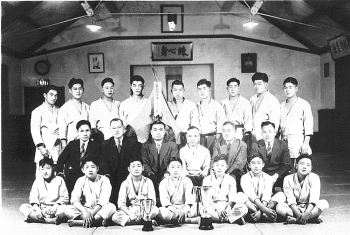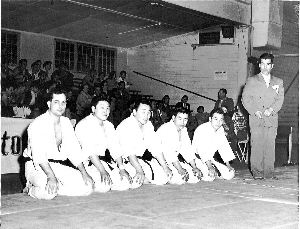Mr. Sato, if we could start with some background biographical
information. Where were you born and where and when did you start judo?
I was born in Seattle in 1927, and I started judo at the Seattle Dojo around 1937, when I was ten or so. I wasnít very good, but they had to put me on the team because there was nobody else. I was always very strong physically, I had a lot of strength, but techniques, you knowÖ You have to have a certain mindset for judo. To contrast it would be football. I was always very good at football. I didnít have any concern for form, for me it was an all-mind experience, no concern for the body. In judo theyíd say, "Youíre using too much strength," "Your form isnít good enough," "That waza [technique] isnít good enough." Of course I got hung up on that, and I worried about form over everything else. But, if I got angry though, I could perform at a very high level. In fact, later, there was this 175-lb. Japanese national champion just over from Japan. Well, I had him down on the mat and I thought I could take him standing up.

Seattle Dojo, April 26, 1940. Courtesy Fred Sato.
The kanji on the back wall reads ren-shin-tai, which translates as "Forge Spirit and Body." Meanwhile, the photos show Jigoro Kano and Tokugoro Ito.
Back row, left to right: Ed Sano, Yozo Sato, (first name not recalled) Murakami, Yasuo "Pete" Fujino, Hank Ogawa, Akira "Frank" Shibukawa, Iwao "Dick" Yamasaki, Junks Kurose, Hisashi "Fred" Shibukawa
Middle row: Unidentified, Yasutaro Miyazawa, Yasuyuki Kumagai (head instructor), Masaichi "John" Shibata, Kanekichi "Kay" Yamaguchi, Hiromu "Kelly" Nishitani
Front row, left to right: Fred Sato, Reo Kanagawa, Ted Shinoda, Shuzo "Chris" Kato, Herbie Amano, Shoji Kanogawa, Yosh "King" Tamura
When you started, who was your judo instructor at the Seattle Dojo, or did they rotate instructors?
The head instructor was from Japan. His name was Kumagai. I don't remember his first name but he was an outstanding man. [EN1] He was a godan [fifth degree] and in those days if you got godan that was pretty high. Godan now isnít the same, Iím a godan, I canít compare myself with him. Very outstanding man, he was only over here for about two or three years. Kudo was another instructor. I think he ended up a shichidan [seventh degree]. [EN2] The guy I was directly underneath was named Shibata, he would put me through the paces. [EN3] There were a lot of other instructors but those are the ones whose tutelage I came under. Later was Furuta, another outstanding man. His best waza was a right-handed shoulder throw, seio-nage and a tai-otoshi. He is still alive; Iím not sure where he lives now, though I could sure find out. [EN4] He was a chief petty officer in the Japanese navy, so obviously he came over after the war. Boy, does he have some stories to tell. And then there was Nakabayashi Sensei, he was the instructor for SAC (Strategic Air Command.) He was about six feet tall; he was all-Japan collegiate judo champion, just an outstanding judo man. He was very unconventional for a Japanese. He was a shichidan, I donít think he would have gotten any higher, because he just doesnít play politics. Nakabayashi Sensei and I hit it off real well he would talk with me like we were on par. Even though at the time I was maybe a sandan or yondan [third or fourth degree]. Thatís it as far as instructors are concerned. The thing that I always remember about their instruction, especially the visiting instructors who would come over because the Seattle Dojo was well thought of in Japan. Kumagai Sensei had spoken highly of the Seattle Dojo. But anyway, the first thing they said was that American judo players were arm happy. Furuta Sensei and Nakabayashi Sensei would say youíve got to use your hips, move your whole body, loosen your arms up. After so many years of hearing that, youíve got to figure it out. Even if youíre lousy, like I was, after a while some of that seeps through and you realize your arms are too tight, youíre tipping your opponent off. I carried this over into my football too, and the wrestling also. This lesson is very vivid in my mind. A lot of students did everything by instinct and plunging into it. Here I was criticized so much for using my strength so I went the other way and became very analytical [about the techniques]. I always tore things apart in my mind; thatís how my mind works. When I would get into tournament play I would try not to use too much strength and so I wasnít very successful. Except if someone got me angry, then I could just cut loose.

Seattle Dojoís 5-man AAU National team, 1954-1956. Courtesy Fred
Sato.
Left to right: George Wilson, Fred Sato, Chris Kato, Tats Kojima, Kenji Yamada. Standing: Isamu Furuta.
When and why did you retire from judo?
It must have been back in 1990 or 91. I wasnít much of a promoter, just by word of mouth. So, sometimes there were fifteen or twenty guys, sometimes one or two. I would come down for that one or two. I must have gotten that from Furuta Sensei, he would always come down for that one or two guys. If I needed help, he was always right there waiting for me. You know, he was a very busy man, those things stick in your mind. I gave up judo because my back was bad. I could roll around on the mat, but I decided just to stick to coaching football and working out at one of these fitness centers. I feel like Iím still learning, and judo and football have dovetailed for me.
Could you describe what the training was like in the early days? Was the focus uchikomi, kata, or randori oriented?
It was more uchikomi, and a lot of randori. But a lot of individual attention. Kumagai, he would take and work out fifteen, twenty guys in a night, one right after another. Sweat just pouring off his body, he would just throw them over and over again. Once in awhile he would let them throw him. I just remember an awful lot of individual attention and fundamentals and repetition. You never felt abused or anything, but they worked you. I remember kangeiko for two weeks in January, the coldest month. Thankfully it never got too cold here. Weíd have to get up at five and work out for an hour, hour and a half before we went to school and then again another practice after school. [EN5]
When did you start teaching judo?
I first started teaching at Marquette -- it was a Jesuit [high] school in Seattle -- in 1953 or 54. I started teaching judo at the YMCA next. And then I went to Puget Sound Junior High and taught there for three years. I had some outstanding players there. I came in to Seattle and taught at Rainer Beach High School. This was where there was the greatest number. I was teaching girlsí class even, a morning class too. The boysí group must have been seventy strong. Then I started teaching at the West Seattle YMCA, they asked me if I would take over, and I did. I had a lot of those guys from Rainier Beach going to the YMCA. I got three of my national champions out of the high school. They were outstanding athletes and they happened to like judo. If they had continued, they could have competed at the national level and maybe international level. They were that good.
Were there many people of non-Japanese descent in the Seattle Dojo pre-war?
No, in fact there was only one Caucasian guy I can remember. He was a tall angular guy. [EN6]
The Seattle Dojo was closed during the war, correct?
Yes, thatís right. [EN7]
Did many of the football and wrestling athletes cross over into judo while you were teaching?
Well, not a lot. From the wrestling to the football, yes. Then I had just a smattering of judo players. I never did analyze why, but judo seemed very controlled to them. It might have been my influence, because I taught in a very detailed manner. Iíd drill on one thing over and over. In judo, the success rate is not very good. In wrestling, you can get some satisfaction just rolling around. In judo, some guys are just very good. This guy named Roger Baldwin was really good. He was a warrior. I have really fond memories of him. He was a downright skinny guy, wasnít that strong, but he was fierce, a great competitor. The tougher it got the better he got. He would go against mature adults and wouldnít back down.
I know that you not only taught school and coached football, wrestling, and judo, but that you also taught conditioning. I understand that you still teach conditioning.
Yes, thatís right.
So, with judo, are you a proponent of weight training?
Oh yes, I was one of the few at that time who did. A lot of guys back then thought it made you tight and muscle-bound.
For Further Reading
Smith, Robert W. Martial Musings: A Portrayal of Martial Arts in the 20th Century (Erie, PA: Via Media Publishing, 1999), 36-40.
Svinth, Joseph R. "Pacific Northwest Judo: The Seattle Dojo, 1924-1953."Michi Online, http://www.michionline.org/fall00/page14.html.
-----. "Sizing 'Em Up: Statistical Relationships between Various Combative Sports in the Japanese American Communities of the Pacific Northwest, circa 1910 to circa 1942." InYo: The Journal of Alternative Perspectives on the Martial Arts and Sciences, http://ejmas.com/jalt/jaltart_svinth1_0300.htm.
-----. "The School of Hard Knocks: Seattleís Kurosaka/Tentoku Kan Judo
Dojo 1928-1942." Journal of Asian Martial Arts, 7:1 (1998), 28-47.
Endnotes
EN1. Yasuyuki Kumagai. He was in Seattle from September 1935 until May 1940.
EN2. Kaimon Kudo. Kudo came to Seattle in 1921, but left in 1935 to become a professional wrestler. At the time of his death in 1993, he was graded 7-dan in judo.
EN3. Masaichi "John" Shibata, who was graded 3-dan. Like several other prewar judo teachers, Shibata was also a seifukushi, or bonesetter.
EN4. Isamu "Sam" Furuta. He is currently living in Seattle, in very poor health.
EN5. Kumagai introduced kangeiko, or winter training, to Seattle in 1935 and it was not practiced again after he left in 1940. During his time in Seattle, the training took place the second and third weeks of January.
EN6. Probably Stanley MacDonald, who earned his 1-dan at the Seattle Dojo during the mid-1930s.
EN7. The Seattle Dojo closed in December 1941, and after the forcible relocation of Japanese Americans in the spring of 1942 it was used to store personal effects of former club members. It reopened for judo in January 1947.